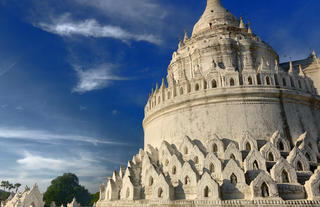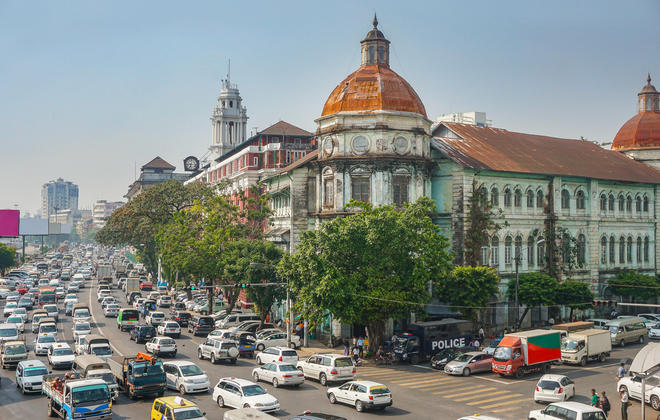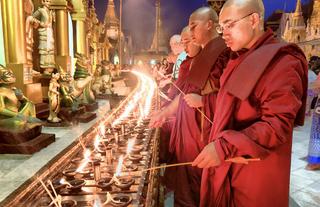Fondly known as 'the land of smiles', Thailand is commonly associated with gorgeous golden sand, palm-lined beaches, warm aquamarine waters, glorious temples and verdant jungle-clad mountains. Thailand is the primary travel hub of Southeast Asia, offering a diverse range attractions and activities to suit all tastes and budgets. Whether exploring the teeming metropolis of Bangkok, relaxing on the tropical beaches of the southern islands, scuba diving in the underwater wonderland off the coast, jungle trekking to hill tribe villages in the North, or discovering the ancient capitals, Thailand is filled with attractions to satisfy any interest.
Bangkok, the “City of Angels,” is a spellbinding study in contrasts—one of the world’s most exhilarating capitals, forever reinventing itself while honouring centuries of royal heritage. Home to Thailand’s grand palaces and many of its most sacred temples, the city pairs deep tradition with a bold, forward-looking spirit. It offers some of Asia’s finest hotels, a constellation of glamorous rooftop bars with sweeping skyline views, and a culinary landscape that effortlessly spans award-winning restaurants and some of the most irresistible, affordable street food on earth. A paradise for shoppers, Bangkok delivers everything from high-end luxury malls to curated designer markets, and it has secured its place on the global touring circuit, drawing major international acts and hosting large-scale live performances throughout the year. Its legendary Muay Thai stadiums add a powerful dose of cultural intensity. Yet beyond the glittering high-rises lies a more intimate city: quiet canals, atmospheric Chinatown lanes lined with Michelin-plate eateries, and the tranquil sanctuary of Bang Krachao—Bangkok’s “Green Lung”—where shaded cycling paths and leafy gardens offer a welcome escape. Vibrant, creative and endlessly multifaceted, Bangkok remains one of the most compelling urban destinations in Asia.





The Khwae Yai River, widely known as the River Kwai, flows through the forested landscapes of Kanchanaburi Province and holds a profound place in both Thai history and global memory. Its name became internationally recognised after the 1957 film The Bridge on the River Kwai, which brought attention to the wartime construction of the Burma Railway during World War II. Today, travellers can visit the iconic Bridge over the River Kwai—a powerful historic landmark—and explore the area’s thoughtfully curated memorial sites, including the JEATH War Museum and the Kanchanaburi War Cemetery. Beyond its historical significance, the river valley is blessed with natural beauty: Erawan National Park’s emerald-tiered waterfalls and scenic hiking trails are within easy reach, while a gentle boat trip along the river reveals misty mountains, traditional riverside life, and a tranquil side of Kanchanaburi that balances remembrance with serene nature.





Phitsanulok (or simply 'P’Lok') is a fairly large, historic city set along the Nan River, in lower northern Thailand. This ancient centre of Thai culture and politics is a busy, dynamic hub and one of the larger of Thailand's provincial capitals. Phitsanulok’s primary tourist attraction is the spectacular Wat Phra Sri Rattana Mahathat, a famous temple built in 1357 housing the Phra Buddha Chinnarat, one of the most revered Buddha figures in Thailand. Other popular attractions include the Chandra Palace, a Buddha image foundry and a nearby folk museum. The city is also known for its excellent markets, its lovely Nan River houseboats, and it’s interesting houseboat museum.





Chiang Mai, the storied “Rose of the North,” stands as the cultural soul of the former Lanna Kingdom, where centuries-old heritage blends effortlessly with contemporary refinement. Within the ancient moat and crumbling city gates lies a walkable old town filled with gleaming Lanna temples, fragrant food markets and curated boutiques showcasing northern craftsmanship. Nearby, the fashionable Nimmanhemin district offers chic cafés, design-led galleries and elegant cocktail lounges, while the Night Bazaar continues to draw visitors with its lively evening atmosphere. Chiang Mai is also a gateway to northern Thailand’s landscapes: forested mountains, rivers and national parks lie only moments away, with Doi Suthep’s revered hilltop temple providing sweeping views over the valley. Anchored by distinctive Lanna cuisine, world-class hotels and easy access to nature, Chiang Mai delivers a refined yet soulful northern Thai experience.





Myanmar remains a land cloaked in mystery, where the path less travelled yields memories that linger for a lifetime. From the endless temple plains of Bagan, to the floating gardens and graceful fishermen of Inle Lake, to the pristine stretches of powdery sand along Ngapali, the country is a visual and cultural feast. Vast and diverse, roughly the size of France and England combined, Myanmar is home to more than 130 ethnic groups, each contributing to its extraordinary cultural mosaic. Stretching from snow-capped Himalayan peaks in the north to coral-fringed islands of the Andaman Sea in the south, Myanmar’s landscapes offer dramatic contrasts: fertile valleys, forested hills, serene rivers, and unspoilt coastlines. Ancient pagodas, royal palaces, and traditional villages pepper the terrain, offering a sense of timelessness and discovery. Whether seeking secluded beaches, cultural immersion, jungle adventures, or contemplative retreats among sacred temples, Myanmar presents an unrivalled opportunity to experience Southeast Asia in its purest and most authentic form—a country both enchanting and remarkably untouched.
The last royal capital of Myanmar. Mention of the word “Mandalay” conjures up sentiments of romance and tragedy, as immortalized in the literary gifts of George Orwell, Rudyard Kipling and Somerset Maugham. The true saga of the last reigning monarch King Thibaw, however, is imbued with romance and tragedy as much as any literary account. Through a combination of deceit, manipulation and false hopes stirred by court advisors and his wife, the fitful reign of King Thibaw ended when the British took Upper Burma in 1885. His family was exiled to India, where they lived in near poverty for the remainder of their lives. Before him, the struggles of the many ancient kings to gain control of the region were as complex and fantastical as a fairy tale.
With British rule, Mandalay’s streets were laid out on a grid system with the large, square palace compound of the former King Thibaw as its epicenter and surrounded by high, red walls and a moat. The effect is unlike any other city in Southeast Asia. With Myanmar’s highest concentration of monks, hundreds of monasteries, and legions of craftsmen, Mandalay is widely regarded as the religious and cultural heart of Myanmar. Among the most venerable pagodas are the Mahamuni Paya, now home to an ancient Buddha image from Rakhine State in western Myanmar, covered in gold leaf by devout Buddhists over many years; and Kuthodaw Paya, with 729 marble slabs bearing inscriptions of the entire Buddhist Tripitaka canon placed around the central stupa. According to legend, on a visit to Myanmar accompanied by his disciple Ananda, the Buddha climbed the 236 meter high Mandalay Hill overlooking the surrounding plains. Standing at the summit, he pointed with arm outstretched to where the Mandalay Palace stands today, and declared that a great city would be founded there after 2,400 years. That year corresponds to 1857 AD, when King Mindon ordered the move of the royal capital from Amarapura to a new city constructed at the foot of Mandalay Hill and bearing its name. Near the top of the hill, a standing Buddha image represents the prophecy.





Resting on the banks of the mighty Irrawaddy River, Old Bagan is both a wondrous UNESCO World Heritage Site and the core of the Bagan Archeological Zone. This charming destination is home to lovely museums, several magnificent temples, enticing shops, and mouth-watering cuisine. Must-see attractions include the famous Shwesandaw Pagoda; the exquisite red-brick facade of the Htilominlo Temple; the interesting exhibitions at the Bagan Archaeological Museum; and the panoramic views from the Atwin Zigon Pagoda. Enjoy a leisurely round of golf at the spectacular 18-hole Bagan Nyaung Oo Golf Club, or wander down to the waterfront and admire the spectacular views and bustling riverside trade.





With a population of over 5 million, Yangon, also known as Rangoon, was the capital of Myanmar up until the end of 2005. It remains the largest city, and is still the pivotal commercial hub of the country today. A visit to this magnificent city will allow you to take in the interesting mix of British, Burmese, Chinese and Indian cultures that mingle there. The skyline is an interesting contrast of decaying colonial architecture and modern high-rises, dominated by the golden glow of the Shwedagon Pagoda, an exquisite Buddhist temple that draws pilgrims from across the globe. Your time here would be well spent visiting the impressive array of temples, museums and markets that the city has to offer.
History Yangon in brief
European countries in a race to control trade routes had established trading posts in across South East Asia. East India Trading company controlled by the British had extended its operations to the Burmese coast and where trading with the Burmese kings. Three Anglo-Burmese wars flared up and in the second Anglo-Burmese war 1852 the British took over Southern Burma and made Rangoon its capital. The old name of Rangoon was Dagon. After third war in 1885 and ousting king Thibaw in Mandalay where the capital was located Rangoon became the capital for the whole country of Burma. Dr William Montgomerie sketched the new plan for the city and Lt Alexander Fraser from the Bengal Engineers implemented. Many architects were employed to fill in the city plan with schools, hospitals, parks, banks, shops and administrative buildings.
Fast forward… the colonial times are long gone, but in Yangon they have left behind a rich architectural heritage, of a type which many other capital cities of the region has been lost to “progress”. Yangon has the largest number of colonial buildings in the whole of Southeast Asia. Many colonial-era buildings that today host state institutions and authorities, such as government banks and the Port Authority, as well as the High Court and City Hall, are clustered in the downtown area. The Strand Hotel is there, too, built by the famous Sarkies Brothers in 1901, and today a sumptuous reminder of a bygone era.
Unlike many of its regional counterparts Yangon is also still first and foremost a green city, despite the battering it received from a cyclone in 2008. In the tranquil settings of Kandawgyi Lake and Inya Lake, and along its wide avenues, Yangon can still boast countless old trees and vegetation. A panoramic view of the city reveals its beauty – with the awe-inspiring Shwedagon Pagoda in its golden hue on one side, on a low hill, and on the other side the ancient Sule Pagoda and its encircling shops in the downtown area.






















